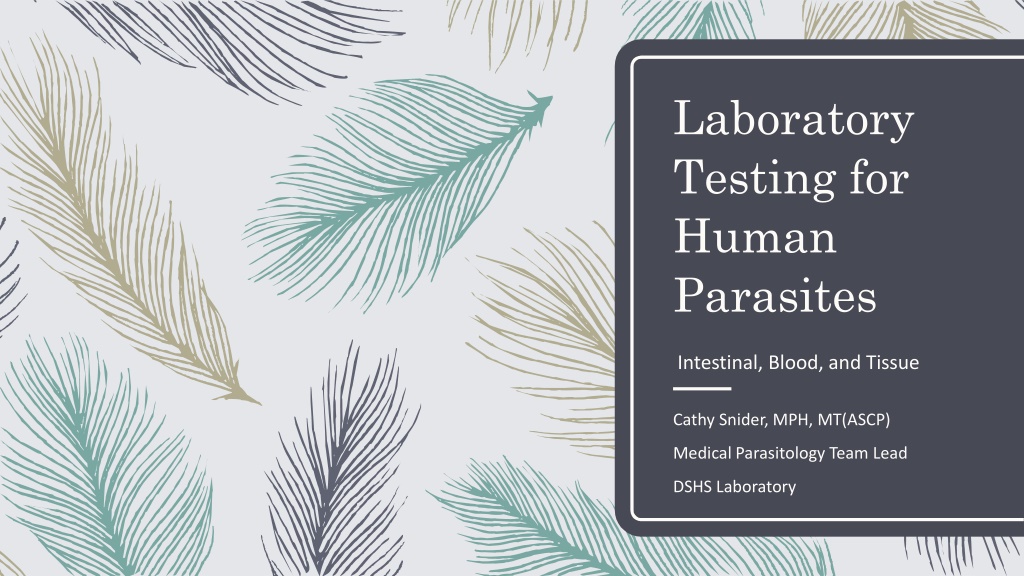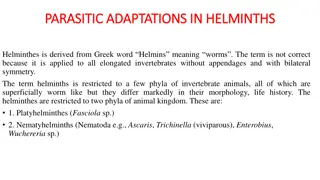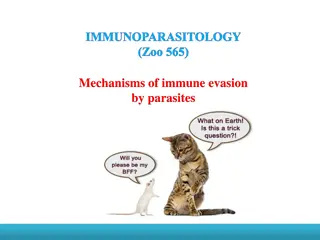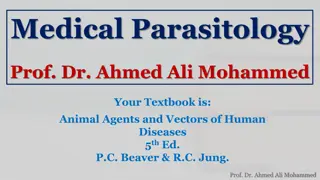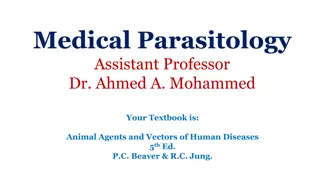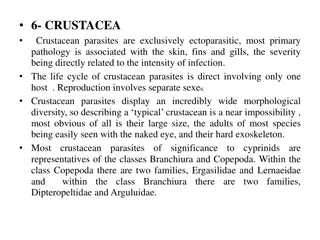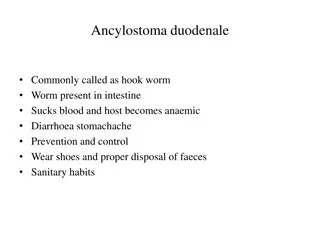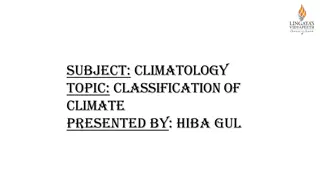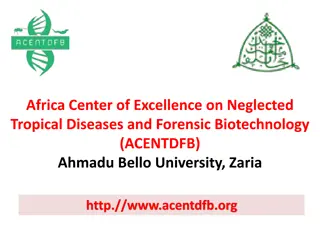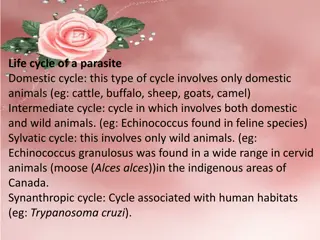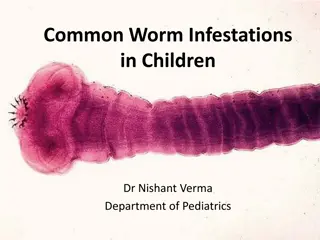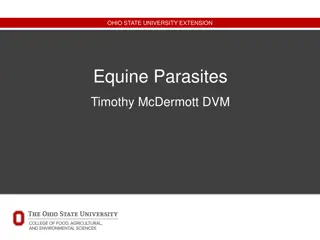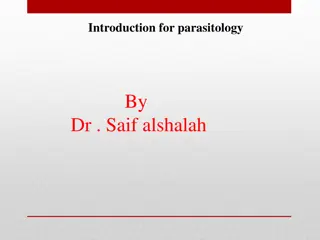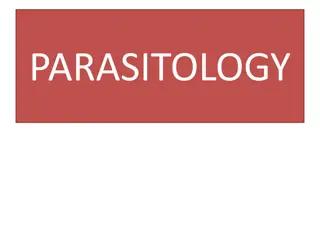Understanding Human Parasites: Laboratory Testing, Neglected Tropical Diseases, and More
Explore the world of human parasites through laboratory testing for intestinal, blood, and tissue parasites. Learn about neglected tropical diseases, common parasitic disease exposures, Texas notifiable conditions, and additional parasites to be aware of. Traditional parasitology techniques involving microscopic visualization remain crucial in diagnosing these infections.
- Human Parasites
- Laboratory Testing
- Neglected Tropical Diseases
- Parasitic Infections
- Medical Parasitology
Download Presentation

Please find below an Image/Link to download the presentation.
The content on the website is provided AS IS for your information and personal use only. It may not be sold, licensed, or shared on other websites without obtaining consent from the author. Download presentation by click this link. If you encounter any issues during the download, it is possible that the publisher has removed the file from their server.
E N D
Presentation Transcript
Laboratory Testing for Human Parasites Intestinal, Blood, and Tissue Cathy Snider, MPH, MT(ASCP) Medical Parasitology Team Lead DSHS Laboratory
Parasitic Protozoa and Helminths In the late 1800s, scientists sometimes referred to parasitology as medical zoology. They were referring to the way they had to understand parasites as real organisms, with natural histories of their own, before they could try to fight the diseases the parasites caused. Carl Zimmer, Parasite Rex
Neglected Tropical Diseases Diseases caused by parasites are ancient conditions that are among the most common infections of the world s poorest people. They make up the majority of what are called Neglected Tropical Diseases or NTDs. In 2015, an estimated 214 million cases of malaria occurred worldwide and 438,000 people died. About 1,500 cases of malaria are diagnosed in the United States each year. (CDC) In 2014, at least 1.7 billion people required mass or individual treatment and care for NTDs, in 185 countries. Of these, 1.1 billion were in lower-middle-income countries. (WHO)
Parasitic Disease Exposures Fecally contaminated environment: Lack of sanitation infrastructure; zoonotic exposure Foodborne: Unsanitary food handling; contaminated or infected food Arthropod vector: Mosquitoes, triatomines, biting flies Miscellaneous: Infection with free living organisms in the environment; sexual transmission; congenital transmission; transfusion/transplant acquired
Texas Notifiable Conditions Amebiasis (E. histolytica) Fascioliasis Ascariasis Paragonimus Cryptosporidiasis Taeniasis (T. solium) Cyclosporiasis Trichinellosis Cysticercosis Babesiosis Echinococcosis Chagas disease Hookworm infection Leishmaniasis Trichuriasis Malaria Amebic meningitis/encephalitis
A few more to keep on your radar Angiostrongylus Baylisascaris Giardia Diphyllobothrium Toxocara Schistosoma Toxoplasma Strongyloides Trichomonas
Traditional Parasitology Microscopic visualization of parasites has long been the traditional method of laboratory diagnosis still a standard. Most human parasites are intestinal infections. Fecal specimens are the specimen of choice. A complete fecal O&P examination consists of two preparations: A concentration of the specimen, to be viewed as a wet mount, and a stained smear. An examination of both preps with a good microscope, by a well trained technologist, provides the best opportunity to detect the full range of intestinal parasites. Supplemental tests targeting particular organisms are appropriate and helpful, but don t replace an O&P.
Other Testing Serology Antibiotic susceptibility tests Histopathology Cultures Special stains Rapid immunoassays Fluorescent antibody tests Molecular tests UV autofluorescence Whole genome sequencing
Morphological Testing at DSHS Routine fecal Ova & Parasite exam (concentrate & trichrome) Acid-fast stain for Cryptosporidium/Cyclospora/Cystoisospora Chromotrope stain for Microsporidia Giemsa stain for malaria and other blood parasites (thick & thin smears) Knott concentration for microfilariae Examination of miscellaneous body fluids by various methods Worm identification
Other Parasite Testing at DSHS Schistosoma serology Strongyloides serology Chagas serology (near future) Malaria PCR Cyclospora PCR (very near future) Triatomine identification
Protozoa Testing at CDC Serological Molecular Other Free Living Amoeba Free Living Amoeba Antibiotic susceptibility Babesia Babesia Identification (multiple tests) Chagas (T. cruzi) Chagas (T. cruzi) Special Studies Leishmania (visceral) Cyclospora Malaria Entamoeba histolytica/dispar Leishmania Morphological Malaria All protozoa Microsporidia Trypanosoma cruzi (in triatomine)
Helminth Testing at CDC Serological Molecular Baylisascaris Angiostrongylus Cysticercosis Echinococcus Morphological Filariasis (Brugia, Wuchereria) All helminths Paragonimus Schistosoma Strongyloides Toxocara Trichinellosis
CDC Referral Testing State health departments and federal agencies may submit specimens for reference testing to CDC. All submissions need approval of the state health department unless part of a special study or surveillance project. CDC Shipping address: Point of contact Centers for Disease Control & Prevention RDSB/STAT 1600 Clifton Road, NE Private citizens, health practitioners, and hospitals must contact their local health department to submit specimens. Atlanta, GA 30333 Contact s telephone number
CDC Referral Testing CDC Infectious Diseases Laboratory Test Directory: State PHL Information: Dr. Grace Kubin, PhD http://www.cdc.gov/laboratory/specimen- submission/cdc-lab-tests.pdf Texas Dept. of State Health Services Laboratory Services Section, MC 1947 1100 W. 49th Street CDC Specimen Submission Form: P.O. Box 149347 http://www.cdc.gov/laboratory/specimen- submission/pdf/form-50-34.pdf Austin TX 78714-9347 1-512-7767318 Please call or email DSHS Medical Parasitology or the Infectious Disease Control Unit to inform us that you are sending specimen to CDC. Thanks 1-512-7767294 Lab.Microbiology@DSHS.state.tx.us
Shipping to DSHS Lab Submit fecal specimens for O&P testing in appropriate preservatives (10% formalin and PVA). Ship at room temperature. Submit serology specimens for CDC referral with serum separated from red blood cells (gel separator tubes are acceptable). Ship all blood specimens on a cold pack. For other questions regarding specimen type, collection, or handling, please call DSHS Parasitology Team at 512-776-7560. For questions regarding shipping, please call Specimen Acquisition at 512-776-7598, or refer to: http://www.dshs.texas.gov/lab/MRS_shipping.shtm To get DSHS submission forms, please call Lab Reporting at 512-776-7578, or refer to: http://www.dshs.texas.gov/lab/mrs_forms.shtm
CDC Telediagnosis DPDx website address: http://www.cdc.gov/dpdx/ DPDx is a web site developed and maintained by CDC's Division of Parasitic Diseases and Malaria (DPDM). For diagnostic assistance, laboratory and other health professionals can ask questions and/or send digital Images of specimens for expedited review and consultation with DPDx staff. The DPDx Team will require a CDC submission form to be submitted with images in order to receive a formal, written lab report. Please send your diagnostic request to dpdx@cdc.gov.
Other CDC links CDC Immigrant and Refugee Health http://www.cdc.gov/immigrantrefugeehealth/guidelines/domestic/intesti nal-parasites-domestic.html http://www.cdc.gov/immigrantrefugeehealth/guidelines/domestic/malari a-guidelines-domestic.html CDC Travelers Health http://wwwnc.cdc.gov/travel/
Contact me: Cathy Snider, MPH, MT(ASCP) Medical Parasitology Team Lead 512-776-7560 phone 512-776-7452 fax cathy.snider@dshs.state.tx.us
